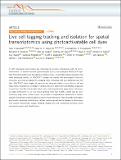Live cell tagging tracking and isolation for spatial transcriptomics using photoactivatable cell dyes
Author(s)
Genshaft, Alex S; Ziegler, Carly GK; Tzouanas, Constantine N; Mead, Benjamin E; Jaeger, Alex M; Navia, Andrew W; King, Ryan P; Mana, Miyeko D; Huang, Siyi; Mitsialis, Vanessa; Snapper, Scott B; Yilmaz, Ömer H; Jacks, Tyler; Van Humbeck, Jeffrey F; Shalek, Alex K; ... Show more Show less
DownloadPublished version (5.319Mb)
Publisher with Creative Commons License
Publisher with Creative Commons License
Creative Commons Attribution
Terms of use
Metadata
Show full item recordAbstract
<jats:title>Abstract</jats:title><jats:p>A cell’s phenotype and function are influenced by dynamic interactions with its microenvironment. To examine cellular spatiotemporal activity, we developed SPACECAT—Spatially PhotoActivatable Color Encoded Cell Address Tags—to annotate, track, and isolate cells while preserving viability. In SPACECAT, samples are stained with photocaged fluorescent molecules, and cells are labeled by uncaging those molecules with user-patterned near-UV light. SPACECAT offers single-cell precision and temporal stability across diverse cell and tissue types. Illustratively, we target crypt-like regions in patient-derived intestinal organoids to enrich for stem-like and actively mitotic cells, matching literature expectations. Moreover, we apply SPACECAT to ex vivo tissue sections from four healthy organs and an autochthonous lung tumor model. Lastly, we provide a computational framework to identify spatially-biased transcriptome patterns and enriched phenotypes. This minimally perturbative and broadly applicable method links cellular spatiotemporal and/or behavioral phenotypes with diverse downstream assays, enabling insights into the connections between tissue microenvironments and (dys)function.</jats:p>
Date issued
2021Department
Massachusetts Institute of Technology. Institute for Medical Engineering & Science; Massachusetts Institute of Technology. Department of Chemistry; Koch Institute for Integrative Cancer Research at MIT; Ragon Institute of MGH, MIT and Harvard; Harvard University--MIT Division of Health Sciences and Technology; Massachusetts Institute of Technology. Department of BiologyJournal
Nature Communications
Publisher
Springer Science and Business Media LLC
Citation
Genshaft, Alex S, Ziegler, Carly GK, Tzouanas, Constantine N, Mead, Benjamin E, Jaeger, Alex M et al. 2021. "Live cell tagging tracking and isolation for spatial transcriptomics using photoactivatable cell dyes." Nature Communications, 12 (1).
Version: Final published version